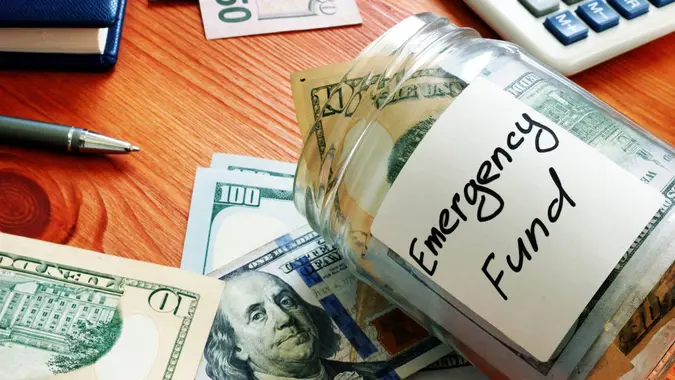How Anyone Can Build an Emergency Fund of $5,000 on Minimum Wage

Commitment to Our Readers
GOBankingRates' editorial team is committed to bringing you unbiased reviews and information. We use data-driven methodologies to evaluate financial products and services - our reviews and ratings are not influenced by advertisers. You can read more about our editorial guidelines and our products and services review methodology.

20 Years
Helping You Live Richer

Reviewed
by Experts

Trusted by
Millions of Readers
If you earn a minimum wage paycheck, building a significant emergency fund can seem futile.
There’s bills to pay and inflation has been rising — so how the heck can you manage to stash away something like $5,000? Fortunately, it’s not some pipe dream — according to experts, it’s absolutely within reach.
“Building an emergency fund of $5,000 while earning minimum wage may seem daunting, but it’s absolutely achievable with discipline and a clear plan,” said Rose Jimenez, financial specialist and chief financial officer at Culture.org.
Kevin Shahnazari, founder and CEO of FinlyWealth, agreed. “Building an emergency fund on a minimum wage salary is entirely achievable with careful planning and dedication. First and foremost, it’s essential to set a clear savings goal,” he said.
Below are their recommended steps to build a solid emergency fund.
The Key Is Starting Small and Staying Consistent
“Begin by setting a realistic savings goal each month,” Jimenez said. “Start with $20 or $50, depending on your budget.” Even small contributions add up over time.
“Automating these savings,” she said, “such as transferring them to a high-yield savings account on payday, ensures the money is set aside before you can spend it.”
Shahnazari advised the same approach. “Breaking down the $5,000 target into manageable monthly contributions can make the process less daunting, allowing individuals to focus on saving a specific amount each month,” he explained. For example, he said saving approximately $417 each month would lead to reaching the goal in one year.
Next, It’s Crucial To Create a Strict Budget
“Tracking all income and expenses helps identify areas where spending can be reduced,” Shahnazari said. This, he explained, enables you to allocate more funds toward savings.
However, it might involve cutting back on discretionary spending, such as dining out or entertainment and redirecting those funds into the emergency fund.
Jimenez agreed cutting expenses is a critical step. “Focus on reducing variable costs like dining out, entertainment or unused subscriptions,” she said. “A client I worked with saved over $100 a month by meal prepping instead of eating out and switching to a more affordable phone plan.”
She noted that pairing these small adjustments with cashback apps or rewards programs can stretch your dollars even further.
Consider Automating Savings Wherever Possible
According to Shahnazari, setting up automatic transfers from your checking account to a dedicated savings account ensures that you prioritize saving before spending.
He explained that this can help build the fund consistently without the temptation to spend that money elsewhere.
“Even small amounts can add up over time,” Shahnazari added.
Boost Your Income
To accelerate savings, Jimenez advised to look for ways to boost income, such as taking on a side gig, selling unused items online or freelancing.
“Many people earning minimum wage have found success by leveraging platforms like Fiverr or Etsy for additional income streams. Every extra dollar earned can go straight into your fund.”
Shahnazari highly recommended this approach, noting that finding ways to increase income can also significantly impact savings.
“Taking on a part-time job or gig work can provide additional funds that can be directly deposited into your emergency fund,” he said. “Every extra dollar earned can contribute to achieving that $5,000 goal faster.”
Don’t Forget To Celebrate Milestones
Shahnazari said it’s important to stay motivated and celebrate milestones along the way. “Recognizing progress, no matter how small, can help maintain momentum and commitment to the savings goal,” he added.
And it makes the journey feel more rewarding. “Setting smaller milestones within the larger goal can provide motivation and a sense of accomplishment,” he said.
Jimenez agreed and gave additional advice: “Keep your goal visible to stay motivated. Break it into smaller milestones–saving $500 at a time feels more manageable than focusing on the full $5,000.
“With persistence and intentional planning, anyone can build a safety net, even on a limited income,” she added.
 Written by
Written by  Edited by
Edited by 
























